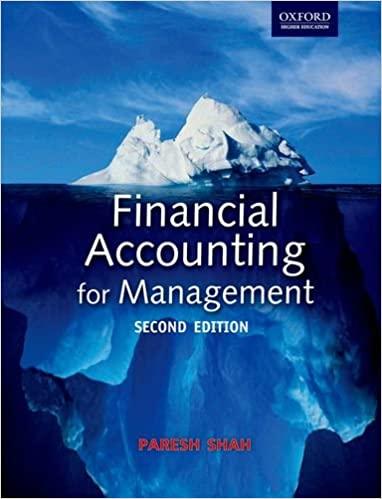



29.7A Mary Smith commenced trading on 1 September 2016 as a distributor of the Straight Cut garden lawn mower, a relatively new product which is now becoming increasingly popular. Upon commencing trading, Mary Smith transferred 7,000 from her personal savings to open a business bank account. Mary Smith's purchases and sales of the Straight Cut garden lawn mower during the three months ended 30 November 2016 are as follows: Sold 2016 September October November Bought 12 machines at 384 each 8 machines at 450 each 16 machines at 489 each 4 machines at 560 each 20 machines at 680 each Assume all purchases are made in the first half of the month and all sales are in the second half of the month At the end of October 2016, Mary Smith decided to take one Straight Cut garden lawn mower out of inventory for cutting the lawn outside her showroom. It is estimated that this lawn mower will be used in Mary Smith's business for eight years and have a nil estimated residual value. Mary Smith wishes to use the straight line basis of depreciation. Additional information: 1 Overhead expenses paid during the three months ended 30 November 2016 amounted to 1,520. 2 There were no amounts prepaid on 30 November 2016, but sales commissions payable of 242 of the gross profit on sales were accrued due on 30 November 2016. 3 Upon commencing trading, Mary Smith resigned a business appointment with a salary of 15,000 per annum. 4 Mary Smith is able to obtain interest of 10% per annum on her personal savings. 5 One of the lawn mowers not sold on 30 November 2016 has been damaged in the showroom and is to be repaired in December 2016 at a cost of 50 before being sold for an expected 400. Note: Ignore taxation. Required: (a) Prepare, in as much detail as possible, Mary Smith's statement of profit or loss for the quarter ending 30 November 2016 using: (i) the first in first out basis of inventory valuation, and (ii) the last in first out basis of inventory valuation. (b) Using the results in (a) () above, prepare a statement comparing Mary Smith's income for the quarter ended 30 November 2016 with that for the quarter ended 31 August 2016. (c) Give one advantage and one disadvantage of each of the bases of inventory valuations used in (a) above, 29.3A From the following figures calculate the closing inventory-in-trade that would be shown using (6) FIFO, (ii) LIFO, (1) AVCO methods on a perpetual inventory basis. Bought Sold January April October 120 at 16 each 80 at 18 each 150 at 19 each June November 125 at 22 each 210 at 25 each 29.5 The sixth formers at the Broadway School run a tuck shop business. They began trading on 1 December 2016 and sell two types of chocolate bar, 'Break' and 'Brunch'. Their starting capital was a 200 loan from the School Fund. Transactions are for cash only. Each Break costs the sixth form 16p and each Brunch costs 12p. 25% is added to the cost to determine the selling price. Transactions during December are summarised as follows: December 6 Bought 5 boxes, each containing 48 bars, of Break; and 3 boxes, each containing 36 bars of Brunch. December 20 The month's sales amounted to 200 Breaks and 90 Brunches. (a) Record the above transactions in the cash, purchases and sales accounts. All calculations must be shown. (b) On 20 December (the final day of term) a physical stocktaking showed 34 Break and 15 Brunch in inventory. Using these figures calculate the value of the closing inventory, and enter the amount in the inventory account. (c) Prepare a trading account for the tuck shop, calculating the gross profit/loss for the month of December 2016. Author's Note (d) Calculate the number of each item that should have been in inventory. Explain why this informa- tion should be a cause for concern. 29.9 After stocktaking for the year ended 31 May 2016 had taken place, the closing inventory of Cobden Ltd was aggregated to a figure of 87,612. During the course of the audit which followed, the undernoted facts were discovered: ) (a) Some goods stored outside had been included at their normal cost price of 570. They had, however, deteriorated and would require an estimated 120 to be spent to restore them to their original condition, after which they could be sold for 800. (b) Some goods had been damaged and were now unsaleable. They could, however, be sold for 110 as spares after repairs estimated at f40 had been carried out. They had originally cost 200. (c) One inventory sheet had been over-added by 126 and another under-added by 72. (d) Cobden Ltd had received goods costing 2,010 during the last week of May 2016 but, because the invoices did not arrive until June 2016, they have not been included in inventory. (e) An inventory sheet total of 1,234 had been transferred to the summary sheet as 1,243. (f) Invoices totalling 638 arrived during the last week of May 2016 (and were included in purchases and in accounts payable) but, because of transport delays, the goods did not arrive until late June 2016 and were not included in closing inventory. (g) Portable generators on hire from another company at a charge of 347 were included, at this figure, in inventory. h) (h) Free samples sent to Cobden Ltd by various suppliers had been included in inventory at the catalogue price of 63. () Goods costing 418 sent to customers on a sale or return basis had been included in inventory by Cobden Ltd at their selling price, 602. 6) Goods sent on a sale or return basis to Cobden Ltd had been included in inventory at the amount payable (267) if retained. No decision to retain had been made. Required










